Heba M. A. Khalil1, Rokaya M. Hassan2
1Soils, Water and Environment Research Institute, Agricultural Research Center, Giza, Egypt
2Cotton Research Institute, Agricultural Research Center, Giza, Egypt
Correspondence to: Heba M. A. Khalil, Soils, Water and Environment Research Institute, Agricultural Research Center, Giza, Egypt.
| Email: |  |
Copyright © 2015 Scientific & Academic Publishing. All Rights Reserved.
This work is licensed under the Creative Commons Attribution International License (CC BY).
http://creativecommons.org/licenses/by/4.0/

Abstract
This study was performed at Giza station, Cotton Res. Inst., Agric. Res. Center, Egypt, during 2012 and 2013 seasons. To decrease the chemical pollution of soil and underground water and study the effect of applying clay soil with rice straw as organic wastes, and the inoculation with some bacterial strains as biofertilizer (PGPR) (Trichoderma reesei, Trichoderma viride, Pseudomonas putida, Bacillus polymexa, Bacillus megaterium). Together with or without rice straw using eco-friendly crop such as, colored cotton because of the lack need for chemicals during bleaching and dyeing processes. As well as, study their effect on soil chemical and biological properties and their impact on the green and brown colored cotton fiber quality comparing to the chemical fertilizers, and cotton yield and some yield components and cotton fiber properties comparing to the control. Green cotton (mutation from G.89), brown cotton (mutation from G.83) and G.86 as white cotton as control. The most important results can be summarized as follows: Adding rice straw achieved the highest content of soil organic matter compared to the rest of the transactions under study. Adding bacterial strains led to increase soil biological activity compared to the rest of the transactions, as well as the control treatments. This reflected directly on all the characters under study. The treatment of mixed bacteria strains (PGPR) and compost in the presence of rice straw increased the soil content of N, P, K elements along with the soil softness, soil total fungi, total counts of bacteria, as well as boll weight (g), lint percentage (%) and seed cotton yield (Kentar/fed.), and fiber structure and physical properties under the study. Also, the white cotton surpassed the green and brown cotton for all factors under the study as well as, the soil biological activity in terms of increasing the total bacterial, total Fungi counts, CO2 evolution. So, we can use this treatment safely to produce bio organic colored cotton. Generally, it could be concluded that the use of the treatment of spraying mixed of bacterial strains (PGPR) and compost in the presence of rice straw is useful for the colored cotton, and enhancement of soil chemical and biological properties. On the other hand, the pervious treatments decreased the degree of pH and EC of the soil. While, influence of cotton rice straw and fertilizers treatment were not significant on fiber cross section perimeter. Also, influence of fertilizers treatment and interaction between genotypes x fertilizer treatments were not significant on upper half mean and uniformity index.
Keywords:
Rice straw, Cotton, Fertilizer, Organic, Compost, PGPR, Fiber
Cite this paper: Heba M. A. Khalil, Rokaya M. Hassan, Raising the Productivity and Fiber Quality of Both White and Colored Cotton Using Eco-Friendly Fertilizers and Rice Straw, International Journal of Plant Research, Vol. 5 No. 5, 2015, pp. 122-135. doi: 10.5923/j.plant.20150505.05.
1. Introduction
In modern cultivation process indiscriminate use of fertilizers, particularly the nitrogenous and phosphorus, has led to substantial pollution of soil, air and water. Excessive use of these chemicals exerts deleterious effects on soil microorganism, affects the fertility status of soil and also pollutes environment [1-3]. The application of these fertilizers on a long term basis often leads to reduction in pH and exchangeable bases thus making them unavailable to crops and the productivity of crop declines. To obviate this problem and obtain higher plant yield, farmers have become increasingly dependent on chemical sources of nitrogen and phosphorus. Besides being costly, the production of chemical fertilizers depletes nonrenewable resources, the oil and natural gas used to produce these fertilizers, and poses human and environmental hazards [4]. So, effort should coordinate to decrease the consequences of the soil chemical pollution. Using eco-friendly fertilizer became the save solution to provide plant with nutrient. Also, the final product is strongly needed to meet the market requires as stated by ICOF [5]. While, Shivalingaiah [6] indicated that Organic cotton production is expected to expand in response to increased demand for organic fibers. Thus, there is a need to study the effect of this fertilizers on the Egyptian cotton quality and quantity because our cottons has a unique fiber properties besides our soil is suffering of lack of minerals since building the high dam as clarified by Arafa and Gebaly [7]. So, we should focus on method helps us to increase the soil fertility, like bio or organic fertilization. The compost application can also improve cotton plant growth promoting rhizobacteria (PGPR), compost and chemical fertilizers significantly affect the growth and yield of different crops [8]. The rice straw application achieved the highest content of soil organic matter adding bacterial strains led to increase the soil biological activity this reflected directly on all the soil and plant characters under the study. The treatment of mixed of bacterial strains (PGPR) and Humic acid in the presence of rice straw was the best for the cotton crop yield and fiber quality as well as the properties of soil chemical and biological artillery compared to the control treatment [9]. Using either Spirulina platensis suspension or Azolla pinnata suspension separately is not enough for enrichment the soil chemicals and biological activities, consequently the fiber properties, but using the mixture of both of them in addition to, the organic fertilizer humic acid gave the best results for all soil characteristics. Also, its save to use bio-organic fertilizers for colored cotton without affecting the colored fiber properties [10]. The white cotton surpassed the green and brown cotton in soil and fiber under study, also concluded that the Egyptian colored cotton need more studies to develop its properties [11]. Mohamed et al. [11] and Dutt et al. [12] indicated that the physical properties of brown cotton i.e. fiber strength, elongation, length, micronaire reading and fineness are on average. Green cotton is longer and stronger than brown cotton. In contrast, the brown cotton is better in maturity ratio and micronaire value while the color cotton in general is lower than those of the white cotton. Although, the colored cotton has poor fiber quality but it naturally has an extremely soft hand or “feel.” and combined with its lake of harmful chemical in finishing and dyeing which increase their need globally. These benefits are maximized by using safe environmentally field practices such as using blue green algae or cyanobacteria. They are photosynthetic microorganisms [6, 13, 14], where the authors found that organic cotton fertilizers like, rice straw, humic acid, solid manures and biofertilizers etc., provide necessary nutrients for plant, improve soil properties and decrease the soil pH that reflected on the crop growth and production. Etesami et al. [15] explained that that PGPR strains, able to augment the plants by interfering the concentration of known phytohormone that those bacteria one of the most important way affect the growth and development is by producing Indole-3 acetic acid IAA that this hormone is led to plant root growth system development and subsequently uptake increase of nutrients by plant. Attia et al. [16] stated that biofertilizer + organic fertilizer + 66% of recommended increased the yield potential and fiber properties of the Egyptian cotton. Similar results was obtained by Dhale et al. [17] who found that the use of bioinoculents are beneficial in improving yield parameters (weight of bolls, number of bolls per plants, seed cotton yield) and fiber quality parameters (span length, uniformity ratio, micronaire value, tenacity, EIG%) up to some extent.
2. Materials and Methods
This investigation was conducted at Giza station, Cotton Research Institute, Agric. Res. Center, Egypt, during 2012 and 2013 seasons to study the effect of organic fertilization on the yield component sand quality properties of the three genotypes (c). Green cotton (mutation from G.89), brown cotton (mutation from G.83) and G86 as white cotton as control and ten fertilizers treatment (F), five including rice straw and the rest without rice straw. Net plot 4 x 4.6 with proper irrigation channels. The following the fertilizers treatment were conducted in this study are shown in table (1).Treatments:Table 1. Layout of the experimental design
 |
| |
|
Rice straw:Rice straw was collected from South El-Hossinia Res. farm Station, El-Sharkia Governorate. It was dry anaerobically and applied to the soil with rate 2.5 ton /feddan during land preparation. The results of these analyses are shown in table (2).Table (2). The analysis of the rice straw
 |
| |
|
Soil analysis:The experimental field soil was sampled initially before conducting the experiment to determine its physical and chemical analyses. The results of these analyses are shown in table (3).Table (3). The physio-chemical of the experimental soil
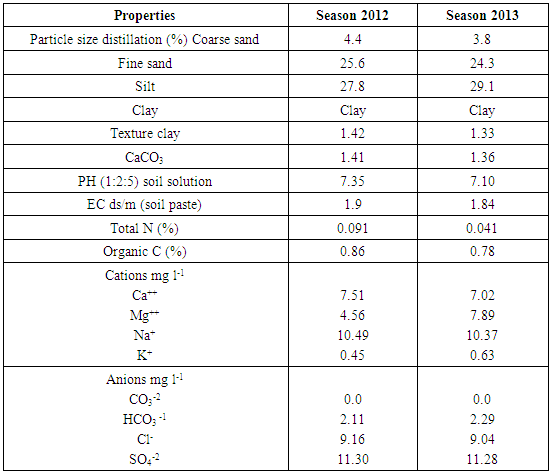 |
| |
|
Compost:Compost obtained from Moshtohor surrounding farm, Kalubia Governorate. The physical and chemical analyses are shown in table (4).Table 4. Some properties of the used organic manure (compost)
 |
| |
|
The studied characters on cotton plant:Yield components: Lint percentage, boll weight and seed cotton yield.Fiber structure propertiesFiber cross section perimeter, maturity ratio, and degree of thickening (%), where the degree of thickening calculated by divided secondary wall area on cross section area and the maturity ratio according to Lord [18]. These parameters were determined using Image analysis instrument.Fiber physical propertiesFiber strength (g/tex), fiber length (mm), uniformity index (%) and micronaire value, these parameter were determined under controlled conditions of 65% ± 2 of relative humidity and 21° ± 2°C temperature. Fiber properties were measured by using High Volume Instrument (HVI) according to ASTM [19].DeterminationsThe main physical and chemical properties of the experimental soil (Table 1) and the analyses of the compost and rice straw were determined according to the standard methods described by Jackson [20] and Page et al. [21]. Plant materials: the oven dried plant materials and determined methods of Page et al. [21]. The plate count using the suitable serial dilutions and specific media was applied for estimation of the examined microbial groups. The media include: Nutrient agar [22] for total count of bacteria, Martin,s agar medium [23] for fungi and Jensen,s medium [23] CO2 evolution was determined according to Gaur et al. [24]. Soil enzymes dehydrogenase activity of the rhizosphere soil assay according to Casida et al. [25], while nitrogenase activity measured by acetylene reduction as described by Hardy et al. [26].Microbiota:Biofertile:An innovative bioformulation produced by the Experimental Studies and Research Unit (ESRU), Faculty of Agriculture, Cairo University was used, for the first time, with Zea mays. This biopreparate is a composite culture of associative and endophyticdiazotrophs (Table 5). PGPR concentration was adjusted to 1x108 (cfu/gr) for all treatments and sprayed in the recommended times of cotton fertilization.Table 5. Diazotrophs formulated in the “Biofertile” multi-strain biofertilizer
 |
| |
|
Statistical analysis:Statistical analysis was a randomized complete blocks design with three replications. LSD 5% test was employed to compare the different means of each studied character, the analysis of variance and LSD test were carried out according to Snedecor and Cochran [29].
3. Results and Discussion
Soil physicochemical propertiesIn this study, there are no changes in the results of soil samples for the three genotypes of cotton, but only the changes between treatments. Results revealed that only the incorporation either with or without rice straw increased the soil organic matter through first season achieved highest result after the second season this may be T5 and T10 contents (Fig. 1), which contribute in stimulate activity of microorganisms at the two seasons, respectively. It was worthy to mention T10 gave high result than T5 because its contents rice straw as organic matter with (PGPR + Compost). All treatments with rice straw tended to achieve relatively higher values of total-N, P and K, as well as enhanced the organic matter in soil, compared to the treatment without rice straw or control. The Two seasons, respectively results were obtained by Badran et al. [30]. However, all treatments with rice straw decreased both EC (Fig. 2) and pH (Fig. 3) as compared to the treatments without rice straw [31]. There was a very slight effect in organic matter (%) and pH value. More flourishing in chemical and biological properties of the soil was attained with (PGPR + Compost) and with rice straw (T10) in the two seasons, respectively. The pH value of the soil was not very slightly affected of any treatment without rice straw, while diminution of the pH value was much pronounced at (T10) these results are in agreement with those obtained by Laxminarayana and Patiram [32].Results of organic matter, total-N (Fig. 4) given in revealed that addition of rice straw led to relative increase in such chemical parameters as compared with absolute control. Moreover, rice straw, (PGPR + Compost) attained the highest values of organic matter, total-N in addition, application of the enriched (PGPR + Compost) to the same preceded treatments exhibited more advancement in the obtained values. The highest values of OM T10, total-N at results in the two seasons, respectively by using (PGPR + Compost) with rice straw. Similar results were obtained by Badran et al. [30].Concerning, the total P (Fig. 5) and K (Fig. 6) in the soil, the results declared that addition of PGPR tended to increase P and K in the soil, particularly with the combined inoculation treatment as compared with other treatments. The results again confirmed the superiority of using the (PGPR + Compost) when accompanied with rice straw at the two seasons, respectively. This result was mainly related to the ability of PGPR to dissolve insoluble phosphate via formation of organic acids and chelating substances. Similar trend was obtained by Laxminarayana and Patiram [32] and Khalil [33]. Moreover, the presence of organic materials (Compost, rice straw) can exhibit same trend phosphate solubilization beside their vital role in enhancement of phosphate dissolvers, as well as increasing soil moisture retention and thus more availability of phosphorus and potassium. These results are closed to those reported by Badran et al. [30]. | Figure (1). Mean organic matter OM (%) in the two seasons |
 | Figure (2). Mean EC in the two seasons |
 | Figure (3). Mean pH in the two seasons |
 | Figure (4). Mean total-N (T.N) in the two seasons |
 | Figure (5). Mean total-P (T.P) in the two seasons |
 | Figure (6). Mean total-K (T.K) in the two seasons |
Soil biological activityOrganic fertilizers are those fertilizers which are manufactured using organic substances which are bio-degradable, i.e. organic fertilizers are naturally occurring fertilizers and nutrient enhancers of the soil [34]. Therefore, every substance likes rice straw and compost that occurs naturally and is easily bio-degradable is organic and if this organic material enhances the richness of the soil, it is termed as organic fertilizer. These organic substances are further decomposed and broken into smaller and soluble particles by PGPR and numerous microorganisms in soil. After being turned into soluble and simpler compounds, these fertilizers are taken in by the roots. In this study the effect of the tested treatment of either microbial inoculation or compost and their combination, initially, no definite trend was detected, since the count of bacteria, and fungi, slightly increased in response of these treatments all with or without rice straw in 2012 and 2013 seasons, respectively but no increased between the soil samples in the three types of cotton for every treatment. However, at flowering stage, generally, the inoculation with either PGPR or compost or their combination increased the count of all tested microorganisms compared to those recorded by uninoculated treatments. Same behavior was observed for the count of bacteria, and fungi, whether plowing with rice straw or not in response of these treatments all with or without rice straw in 2012 and 2013 seasons, respectively. However, at flowering stage, generally, the inoculation with either PGPR or compost or their combination increased the count of all tested microorganisms compared to those recorded by uninoculated treatments. Same behavior was observed for the count of bacteria (Fig. 7), and fungi (Fig. 8), whether plowing with rice straw or not. However, the treatment (T10) of PGPR as foliar spray and compost applied with plowing rice straw gave the highest values of all soil biological activity parameters treatment, i.e. total bacteria count 44.9, 44.9, and 44.8 (Green cotton, Brown cotton and White cotton) in the two seasons, respectively and 46.9, 46.9, and 46.9 (Green cotton, Brown cotton and White cotton) in the two seasons, respectively (105 cfu g-1 soil) and total fungi 67, 67.2, 67.1 and 69.1, 68.9, 69.2 fungi (Green cotton, Brown cotton and White cotton) in the two seasons, respectively (104 cfu g-1 soil).CO2 evolution (Fig. 9) was increased from 44.51, 44.52, 44.50 and 46.14, 46.13, 46.14 CO2 evolution (Green cotton, Brown cotton and White cotton) in the two seasons, respectively (mg 100g soil-1) under the treatment plowing rice straw at (2012 and 2013) two seasons, respectively. On the other hand, the treatment (T5) decreases without plowing rice straw, i.e. total bacteria count 29.1, 29.1, 29 and 31.2, 31.4, 31.3 cfu g-1 dry soil (Green cotton, Brown cotton and White cotton) in the two seasons, respectively. While, total fungi 51.1, 69.9, 51.1 and 52.4, 52.5, 52.5 cfu g-1 dry soil (Green cotton, Brown cotton and White cotton) in the two seasons, respectively, and CO2 evolution decreases without rice straw achieved 30.57, 30.58, 30.59 and 30.88, 30.89, 30.87 mg 100g-1 dry soil (Green cotton, Brown cotton and White cotton) in the two seasons, respectively.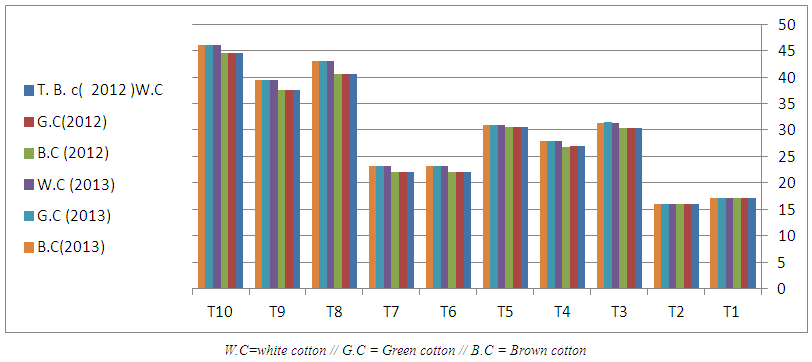 | Figure (7). The total count of bacteria to three genotypes of cotton in the two seasons |
 | Figure (8). The total fungi to three genotypes of cotton in the two seasons |
 | Figure (9). The CO2 evolution to three genotypes of cotton in the two seasons |
Cotton properties:Data shown in table (6), illuminating that, the effect of all the factors under the study and their interaction on lint percentage (%) was significant in both seasons. Regarding the genotypes, the white cotton gave the highest values of lint percentage (%) than colored cotton (green and brown) were (39.05, 34.79 and 32.86), (39.11, 34.82 and 32.90) in both seasons; respectively. Concerning the fertilizer treatment, the mixture of compost + PGPR with rice straw gave the highest values of lint percentage (%) for all genotypes than other treatment with average (36.27 and 36.29) in both seasons; respectively. While, the treatment 50% of mineral fertilizer gave the lowest values for all genotypes with average (34.71 and 34.87) in 2012 and 2013, respectively. As for the interaction between genotypes x fertilizers treatment, the white cotton under the mixture of compost + PGPR with rice straw gave the best values of lint percentage (%) were (40.14 and 40.16) in both seasons, respectively. This may be attributed to that the significant increase in microbial, bacteria and fungi was observer with the addition of rice straw. On the other hand, the white cotton under the mixture of compost + PGPR without rice straw gave the lowest values of lint percentage (%) were (32.09 and 32.24) in both seasons, respectively. This result was similar for Attia et al. [16] and Dhale et al. [17].Table 6. Effect of genotypes and eco-fertilizer on lint percentage (%) in 2012 and 2013 seasons
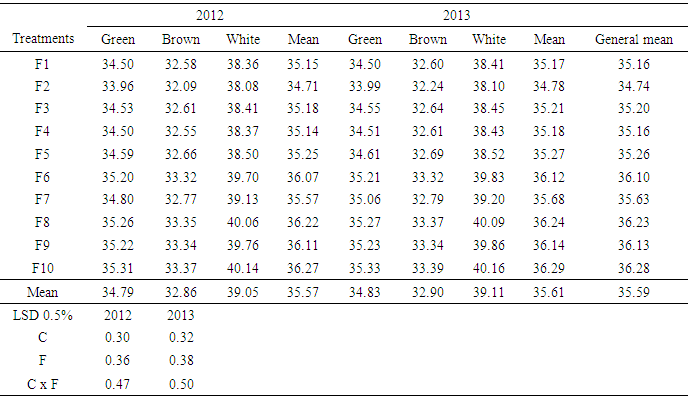 |
| |
|
Data recorded in tables (7 and 8), shown that, the result of boll weight and seed cotton yield took the same trend lint percentage (%).Table 7. Effect of genotypes and eco-fertilizer on boll weight (g) in 2012 and 2013 seasons
 |
| |
|
Table 8. Effect of genotypes and eco-fertilizer on seed cotton yield (K/F) in 2012 and 2013 seasons
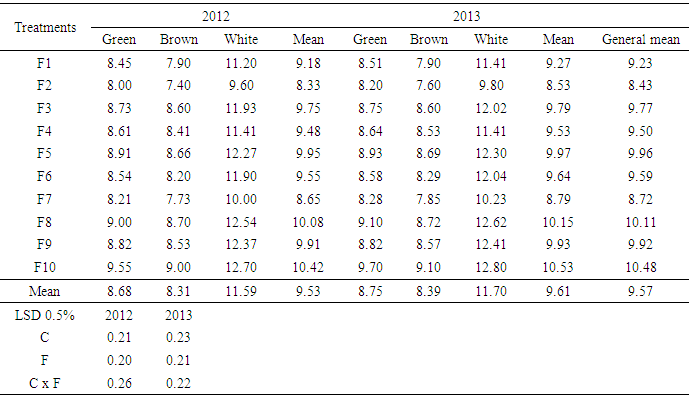 |
| |
|
It’s clear from table (9), that the effect of the genotypes was significant in 2012 and 2013 seasons. The white cotton gave the better values than the green and brown cotton were (47.30, 50.80 and 51.03), (47.25, 50.73 and 50.98) in both seasons, respectively. While, the effect of the fertilizers treatments were not significant for cross section perimeter in both seasons. This result may be due to that cross section perimeter genetic characteristic inside the variety. Table 9. Effect of genotypes and eco-fertilizer on cross section perimeter (µ) in 2012 and 2013 seasons
 |
| |
|
Data aforementioned in table (10), clarified that, degree of thickening values for all the factors under the study and their interaction were significant in both seasons. With regard to the genotypes, the white cotton surpassed green and brown cotton in both seasons. Concerning the fertilizers treatment, adding compost + PGPR + rice straw gave the highest values of degree of thickening in both seasons. On the other hand, the treatment 50% mineral fertilizer gave the lowest values in both seasons. The interaction between genotypes x fertilizers treatment, the white cotton under treatment with mix of compost +PGPR + rice straw gave the best values were 80.10 and 72.20 in both seasons, respectively. However, the treatment 50% of the recommend mineral dose without rice straw for brown cotton gave the lowest values of degree of thickening were (59.00 and 60.00) in 2012 and 2013 season, respectively. Table 10. Effect of genotypes and eco-fertilizer on degree of thickening (%) in 2012 and 2013 seasons
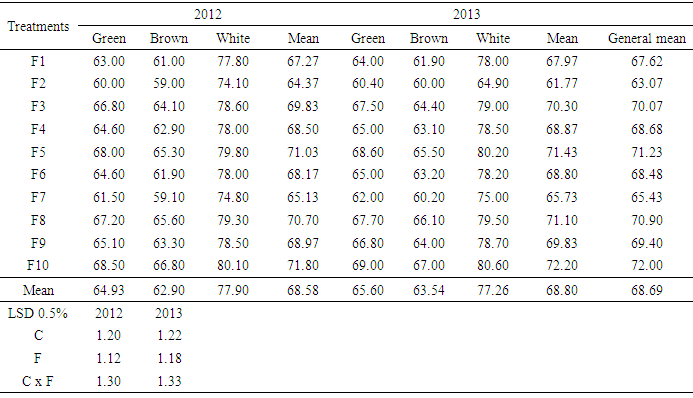 |
| |
|
It’s obvious from table (11), that the effect of the genotypes, fertilizer treatment and interaction were significant in both seasons. With regard to the genotypes, the white cotton gave the highest values of micronire values were (4.13 and 4.24) in both seasons, respectively. Concerning the fertilizers treatment, we obtained on highest values of micronaire of the treatment (mix of compost + PGPR + rice straw) were (4.43) in both seasons. As to, the interaction between genotypes and fertilizers treatment was the white cotton under treatment mixture of compost + PGPR in presence rice straw gave the highest micronaire values (4.5 and 4.6) in 2012 and 2013 seasons, respectively. Per contra, the interaction between brown cotton and 50% mineral without rice straw gave the lowest values was (3.6) in 2012 season while in 2013 season the green and brown cotton gave the same value (3.7) in this treatment. It is worthy to refer to that maicronair value incorporate both of fineness and maturity, fineness is a genetic factor so, it influences by the genotypes while, maturity is affected by environment so, the variation between the three genotypes expresses fineness while the variation between the fertilizer treatments inside variety expresses maturity. These results are in harmony with Arafa et al. [9] and Attia et al. [16].Table 11. Effect of genotypes and eco-fertilizer on micronaire value in 2012 and 2013 seasons
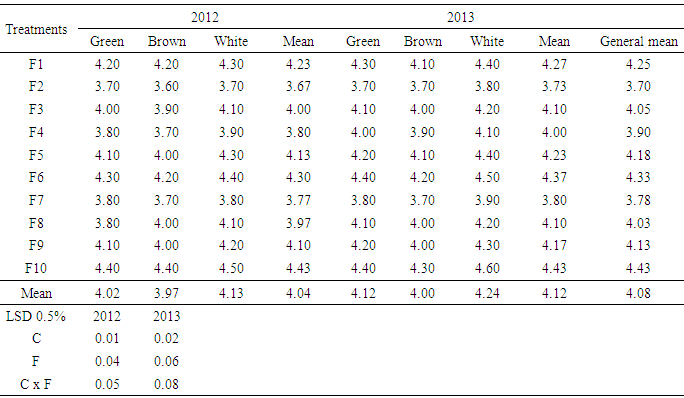 |
| |
|
Data recorded in table (12), clarified that, the maturity ratio values for all factors under the study and interaction between genotypes and fertilizers treatment were significant in both seasons. Concerning the white cotton surpassed the green and brown cotton for all fertilizers treatment in both seasons. As for fertilizers treatment, compost + PGPR + rice straw increased maturity ratio values than other fertilizers treatment in both seasons. However, the treatment 50% the recommended mineral dose gave the lowest values of maturity ratio. With regard to the interaction between genotypes x fertilizers treatment, the mix of compost + PGPR + rice straw gave the highest values of maturity ratio for white cotton were (0.96 and 0.97) in both seasons; respectively. These results are in harmony with Arafa et al. [9] and Attia et al. [16].Table 12. Effect of genotypes and eco-fertilizer on maturity ratio in 2012 and 2013 seasons
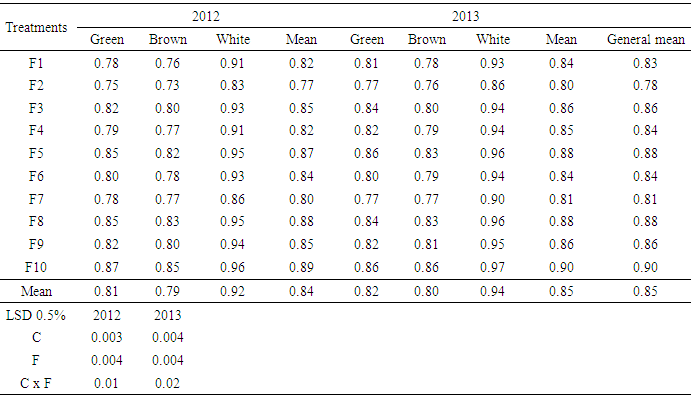 |
| |
|
From data shown in table (13), we can deduce that, the highest values of fiber strength (44.52 and 44.60) were obtained from the treatment compost + PGPR with rice straw for the white cotton in both seasons, respectively. This may be due to that mixture of compost + PGPR + rice straw works in its best way when the pH of soil is acidic due to the decrease in soil pH due to active the soil bacteria and the ability of root uptake which reflected in plant metabolism, which lead to morphs and uniform deposition of the cellulose layers of secondary cell wall that made the fiber able to bear the tension load. On the other hand, the lowest values of fiber strength were (33.12 and 30.15) in both seasons, respectively; this was due to the treatment of 50% mineral fertilizer without rice straw. Adding the white cotton gave the best values of fiber strength because it was more maturity than the green cotton followed it brown cotton. Table 13. Effect of genotypes and eco-fertilizer on fiber strength (g/tex) in 2012 and 2013 seasons
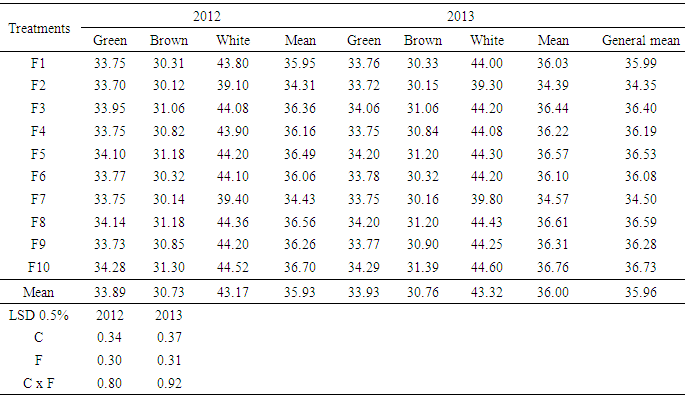 |
| |
|
It’s clear in table (14), that the different between genotypes was significant in both seasons while the effect of fertilizers treatment and interaction between genotypes x fertilizers treatment were not significant in both seasons. The white cotton surpassed the green cotton followed brown cotton for all fertilizers treatment (32.31, 29.42 and 28.53), (32.32, 29.45 and 28.63). This result may be due to that the environment effect is limited on the fiber length because it is associated with genetic factor. Adding the combination compost + PGPR + rice straw gave the highest values of upper half mean than the other fertilizers treatment for three genotypes were (30.57 and 30.68) in both season, respectively. As for interaction between genotypes x fertilizers treatment, the white cotton under treatment mixed of compost + PGPR + rice straw gave the best values were (32.20 and 33.40). On the other hand, the brown cotton under 50% mineral without rice straw gave the lowest values of fiber length (28.10 and 28.24) in both seasons, respectively. These results are in harmony with Arafa et al. [9] and Dhale et al. [17].Table 14. Effect of genotypes and eco-fertilizer on fiber length (mm) in 2012 and 2013 seasons
 |
| |
|
Data recorded in table (15), found that, the results of uniformity index took the same direction as the previous table, the private fiber length. Table 15. Effect of genotypes and eco-fertilizer on uniformity index (%) in 2012 and 2013 seasons
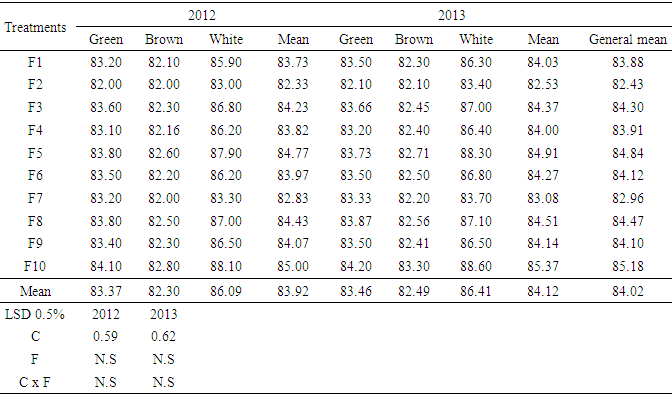 |
| |
|
4. Conclusions
In general, it is from this study can be drawn that adding rice straw achieved the highest content of soil organic matter adding bacterial strains led to increase the soil biological activity this reflected directly on all the soil and plant characters under the study. The treatment of mixed of bacterial strains (PGPR) and compost in the presence of rice straw was the best for the cotton crop yield and fiber quality as well as the properties of soil chemical and biological artillery compared to the control treatment.
References
| [1] | Youssef MMA, Eissa MFM (2014). Bio-fertilizers and their role in management of plant parasitic nematodes. E J Biotechnol Pharm Res 5: 1-6. |
| [2] | Sofy AR, Attia MS, Sharaf AMA and El-Dougdoug KA (2014a). Bean yellow mosaic potyvirus potential on nodulation and N2-fixation of faba bean plants. N Y Sci J 7(9): 101-109. |
| [3] | Sofy AR, Attia MS, Sharaf AMA and El-Dougdoug KA (2014b). Potential impacts of seed bacterization or salix extract in faba bean for enhancing protection against bean yellow mosaic disease. Nat Sci 12(10):67-82. |
| [4] | Joshi KK, Kumar V, Dubey RC and Maheshwari DK (2006). Effect of chemical fertilizer adaptive variants, Pseudomonas aeruginosa GRC2 and Azotobacter chroococcum AC1 on Macrophomena phaseolina causing charcoal rot of Brassica juncea. Korean J Environ Agric 25: 228-235. |
| [5] | International Conference on Organic Farming (ICOF) (2010). Friendship Hall, Khartoum, Sudan 6-7 April. |
| [6] | Shivalingaiah M (2007). Effect of nutrient management and plant protection practices in organic cotton production (Gossypium spp.) M.Sc. Thesis, University of Agricultural Sciences, Dharwad. |
| [7] | Arafa AS and Gebaly SG (2007). Cotton yield and fiber quality variation related to fertilization with poultry litter, microbial and mineral nitrogen. The first Arab Conf. on Environ. St. and Res. "The contemporary and future environmental issues in the Arab region" Ain shams Univ. |
| [8] | Heba M.A. Khalil and Abeer S. Arafa, 2013. Influence of Rice Straw and Bio-organic Fertilizers on Cotton Fiber Quality under Saline Soils. Journal of Agronomy, 12: 86-92. |
| [9] | Arafa AS, Khalil HMA and Gebaly SG (2013). Impact of eco-friendly fertilizers and rice on cotton yield and fiber physical properties. International Science and Investigation Journal 2(1): 1-12. |
| [10] | Arafa AS and Abd El-All A (2013). Evaluation of the technological properties of the Bio-organic colored cotton. Journal of Agronomy 12(2): 78-85. |
| [11] | Mohamed AS, Abd El-Bary AMR and Hassan RM (2010). Study on Egyptian naturally colored cotton compared with some conventional uncolored cottons. J. Biol. Chem. Environ. Sci. 5(2): 289-305. |
| [12] | Dutt Y, Wang XD, Zhu IGY and Li IYY (2004). Breeding for high yield and fiber quality in colored cotton. Plant Breed. 123: 145-151. |
| [13] | Kevin VJ (2003). Plant growth promoting rhizobacteria as biofertilizers. Plant and Soil 255: 571-585. |
| [14] | Twewaadha E and Alweendo SR (2007). The Effect of nitrogen, phosphorus and potassium fertilizers on cotton cultivar (TETRA) The World Cotton Research Conference-4 (September 10-14, 2007). |
| [15] | Etesami H, Alikhani HA, Jadidi M and Aliakbar A (2009). Effect of Superior IAA Producing Rhizobia on N, P, K Uptake by Wheat Grown under Greenhouse Condition World Applied Sciences Journal 6(12): 1629-1633. |
| [16] | Attia AN, Sultan MS, Said EM, Zina AM and Khalifa AE (2008). Effect of the first irrigation time and fertilization treatments on the growth, yield, yield component and trails of cotton. Journal of Agronomy 7(1): 70-75. |
| [17] | Dhale DA, Chatte SN and Jadhav VT (2011). Response of bioinoculents on growth, yield and fiber quality of cotton under irrigation. Agric. Biol. J. N. Am. 2(2): 376-386. |
| [18] | Lord E (1981). The origin and assessment of cotton fibre maturity. Int. Inst. for Cotton. Technical Research Division, Kingston Road, Didsbury, Manchester, U. K. |
| [19] | ASTM (1986). American stander for testing materials (ASTM), D-3818, D- 4605-1986 and D: 2288-93.USA. |
| [20] | Jackson ML (1976). Soil chemical analysis. Prentice-Hall, Inc. Engle Wood Cliffs, N.J., 498 PP. |
| [21] | Page AL, Miller RH and Keeney DR (1982). Methods of Soil analysis. Ii Chemical and Microbiological Properties. Soil Sci. Amer, Madison Wisconsin, USA. |
| [22] | Difco manual. Microbiological laboratory procedures, 9th ed., Difco Laboratories, USA (1977) 855. |
| [23] | Allen ON (1959). "Experiments in Soil Bacteriology" 3rd ed. Burgess Pabl. Co. USA, PP. 117. |
| [24] | Gaur AC, Sadasivan KV, Vitumal OP and Mathur RS (1971). A study of decomposition of organic matter in an alluvial soil, CO2 evolution mycological and chemical transformation. Plant and soil 34: 17–28. |
| [25] | Casida LE, Klein DA and Santoro T (1964). Soil dehydrogenase activity. Soil Sci. 98: 371-376. |
| [26] | Hardy FNE, Burns RC and Holsten RD (1973). Application of the acetylene – ethylene assay for measurement of nitrogen fixation. Soil Biol. Biochem. 5: 47–81. |
| [27] | Hamza MA, Youssef H, Helmy A, Amin GA, Fayez M, Higazy A, El-Khawas HM, Monib M, Sedik MZ and Hegazi NA (1994). Mixed cultivation and inoculation of various genera of associative diazotrophs. In: Hegazi, N. A; Fayez, M. and Monib, M. (eds.), Nitrogen Fixation with Non-Legumes. |
| [28] | Ferial MR, Hosny HK, Waleed DS and Mohamed AM (2011). Impact of rice straw composts on microbial population, plant growth, nutrient uptake and root-knot nematode under greenhouse conditions. African Journal of Agricultural Research 6(5): 1188-1203. |
| [29] | Snedecor GW and Cochran WG (1986). Statistical Method 7th Edition Iowa. State Univ., Press, Ames, Iowa, USA. |
| [30] | Badran NM, Khalil MEA and El-Emam MAA (2000). Availability of N, P and K in sandy and clayey soils as affected by the addition of organic materials. Egypt. J. Soil Sci. 40: 265-283. |
| [31] | Siam HS, Shaban KhA and Safaa AM (2013). Evaluation of applying different mineral nitrogen sources on soil fertility and wheat productivity under saline soil conditions. J. Applied. Sci. Res. 9(4): 3146–3156. |
| [32] | Laxminarayana K and Patiram (2005). Influence of inorganic, biological and organic manures on yield and nutrient uptake of groundnut (Arachis hypogeae) and soil properties .Indian J. Agric. Sci. 75: 218-221. |
| [33] | Khalil HMA (1999). Chelating Biofertilizer production from crop residues and it's utilization in African marginal soils", Thesis Department of Natural Resources (Soil Resources, Soil Microbiology), AIRS, Cairo University. |
| [34] | Bokhtiar SM and Sakurai K (2005). Effects of organic manure and chemical fertilizer on soil fertility and productivity of plant and ratoon crops of sugarcane. Archives of Agronomy and Soil Science 51: 325-334. |












 Abstract
Abstract Reference
Reference Full-Text PDF
Full-Text PDF Full-text HTML
Full-text HTML













